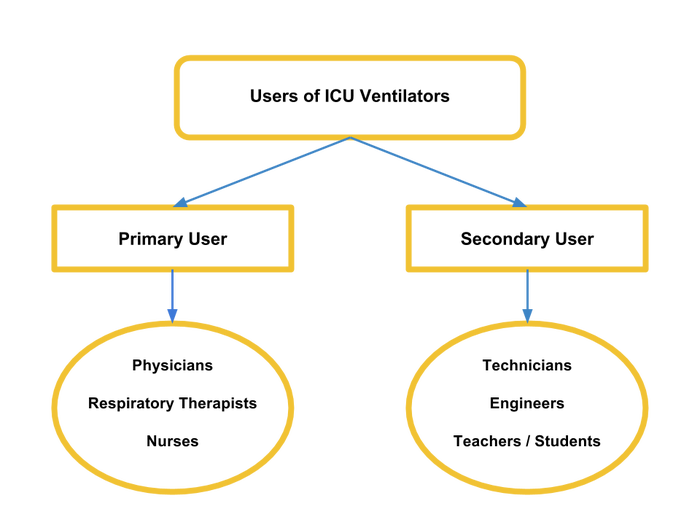Ventilator vs. healthcare professional vs. patient, time to talk!
Last update: Wednesday, 26 Oct 2016 at 18:11
Do you know how to use most of the features of your ventilator?

Source: www.xlung.net
Probably not.
Perhaps this statement is a little frightening, but it is the truth. Not only are their full capabilities under-utilized, but often their main functions are handled improperly. When a piece of life support equipment is not used correctly this can cause serious damage to the health of the patient. The exact person that should be helped by mechanical ventilation (1).
Some studies have been conducted to evaluate the usability of these devices and increasingly they have shown that there are many limitations to the ergonomics and the quality of the user interfaces of mechanical ventilators (2, 3) .
Analyzing data related to the damage caused by mechanical ventilators to patients, there are high rates of adverse events, and even deaths, resulting from problems during ventilatory support. According to data collected by the FDA (Food and Drug Administration) using the MAUDE (Manufacturer and User Facility Device Experience) platform, there were 14 deaths caused directly by mechanical ventilators in the USA (United States of America) in 2013. The numbers are even higher when looking at non-fatal injuries caused by the ventilator: 946 reports of adverse events last year alone (unpublished data) (4). In Brazil we do not have similar recording of data, which is, no doubt, quite worrying.
In 2002, a sentinel commission warned that 87% of cases of injury and death related to the use of mechanical ventilators were avoidable (5).
The question that must be asked: what leads to such poor use of mechanical ventilators in the ICU by professionals who use this equipment?
The main factor is due to problems with the interaction between man and machine, i.e. the way a person uses and accesses a particular machine. Another essential point is what is called "usability."
According to the International Organization for Standardization (ISO 9241) (6), "usability" is defined as: "Extent to which a product can be used by specified users to achieve specified goals with effectiveness, efficiency and satisfaction in a specified context of use." This measure can be interpreted as the quality of the user interface of the equipment (7).
In the field of mechanical ventilation, specific users, also known as Primary Caregivers, are all healthcare professionals who deal with mechanical ventilators in ICUs. Secondary Caregivers are those who use this equipment for any purpose other than ventilatory support itself. See the chart below:

Figure 1. Mechanical Ventilators Users Classification
How to approach this important and complex problem?
Perhaps the first step should be a better unification of concepts and language used in mechanical ventilation. "Ventspeak" it is not an easy language indeed. Although many professionals are familiar, and feel comfortable, with existing nomenclatures, there is a need to standardize the taxonomy and syntax as well as better classification and description of ventilation modes and their settings (8, 9). There should also be a standardization of the design and layout of the user interface screens of the ventilators to better them to be used by any health professional with experience with, and basic knowledge of, mechanical ventilators' interfaces, regardless of the brand or model of the equipment being used (2).
It is well known that the working memory of humans is limited and it has been noted that a number of physiological functions and variables shown on the screens of cutting-edge ventilators are excessive. This results in a large cognitive load on the user, which can compromise the process of analysis and decision making in critical situations, which could lead to errors (10). The fact that many professionals misuse or misinterpret ventilator alarms during day-to-day use in ICUs, is common knowledge and corroborates this idea.
Another important step is to perform usability testing during the development stage of the interfaces of the mechanical ventilators. These interfaces should have their planning and design guided by the concepts, ideas, and experiences of professional primary users. The developer and manufacturer of mechanical ventilators should support the creation process of the equipment based on the needs and experiences of the users. Developers and manufacturers should utilize the ideas, knowledge, needs, and experience of professional primary users when designing mechanical ventilators. Thus, fabricating devices which have better usability, are more user friendly, and are more efficient than current models.
Finally, we would like a third step towards the better use of mechanical ventilatory support; targeted training for healthcare professionals, from the graduate level on up to all higher levels of expertise. In the meantime, approaches based on simulation can be an excellent alternative. Both virtual simulation and hands-on simulation with ventilators and mannequins expand the opportunities, options, and tools for teaching the subject of mechanical ventilation, while offering more security, satisfaction, and efficiency in the teaching-learning process (11-13).
Preliminary studies have shown that rapprochement between users and manufacturers/developers of mechanical ventilators is possible and highly beneficial for all parties involved. One has to recognize, however, that we are only in the beginning stages of this process (14,15).
It should also be reflected upon that not everything easy and enjoyable to use becomes, in fact, useful. Being useful not only assumes the availability of technological resources necessary for its purpose, but also adequate accessibility for users, and good usability therein. In other words, the ventilator will be fully useful only when merging utility with usability (Figure 1).

Figure 2. An useful device effectively combines utility and usability.
This is the contemporary challenge that requires manufacturers and users of mechanical ventilators, who are all in the end part of the same team whose goal is to save lives when they are most threatened.
Authors:
Nathalia Parente de Sousa,
Physiotherapist, Master of Medical Science in the Laboratory of Respiration, "Resplab", Federal University of Ceará (UFC)
Andréa Kelly Carvalho,
Physiotherapist, Master and PhD in Health Sciences, UNIFESP (Federal University of São Paulo)
Visiting Professor of Postgraduate Courses in Cardiorespiratory Physical Therapy UNIFOR (University of Fortaleza)
Marcelo Alcantara Holanda,
Associate Professor of Pneumology and Intensive Therapy, Federal University of Ceará (UFC)
Founder of the "xlung" Platform for Teaching and Learning MV
References:
1 RICHARD, J.C.M.; KACMAREK, R.M. ICU mechanical ventilators, technological advances vs. user friendliness: the right picture is worth a thousand numbers. Intensive Care Med. v. 35, p. 1662–1663, 2009.
2 LAURENCE, V.; DIDIER, T.; PHILIPPE, J. Evaluation of the userfriendliness of seven new generation intensive care ventilators. Intensive Care Med. v. 35, p. 1687–1691, 2009.
3 GONZALEZBERMEJO, J.; LAPLANCHE, V.; HUSSEINI, F.E.; DUGUET , A.; DERENNE, JP.; SIMILOWSKI, T. Evaluation of the userfriendliness of 11 home mechanical ventilators. Eur Respir J. v. 27, p. 1236–1243, 2006.
4 MANUFACTURER AND USER FACILITY DEVICE EXPERIENCE. Food and Drug Administration. United States of America. Available at: www.accessdata.fda.gov/scripts/cdrh/cfdocs/cfMAUDE/search.CFM Accessed/Referenced on: February 20, 2014.
5 JOINT COMMISION. Preventing ventilator related deaths and injuries. Sentinel Event Alert. v. Feb 25, 2002.
6 ISO 9241. ASSOCIAÇÃO BRASILEIRA DE NORMAS TÉCNICAS. Ergonomics of Software for Offices. 1993.
7 HIX, D.; HARTSON, H.R. Developing user interface, ensuring usability through product & process. New York. John Wiley & sons, Inc. 1993.
8 CHATBURN, R.L.; VOLSKO, T.A.; HAZY, J.; HARRIS, L.N.; SANDERS, S. Determining the Basis for a Taxonomy of Mechanical Ventilation. Respiratory Care. v. 57, n. April 4, 2012.
9 CHATBURN, R.L. Classification of Ventilator Modes: Update and Proposal for Implementation. Respiratory Care. v. 52, n. March 3, 2007.
10 COWAN, N. The magical number 4 in shortterm memory: A reconsideration of mental storage capacity. Behavioral and Brain Sciences, v. 24, n. 3, p 87185, 2001.
11 HOLANDA, M.A.; FILHO, M.L.; REIS, R.C.; RANGEL, D.; ALCANTARA, D.M.; OLIVEIRA, N.H.; MARINHO, L.S.; DONATO, E.; CORTEZ, P.C. Efficacy of a computer simulator program (xlung™) for teaching mechanical ventilation in complex clinical scenarios to medical students. Am J Respir Crit Care Med. v. 185, n. 1(Meeting Abstracts), p. 1610A, 2012. doi: 10.1164/ajrccmconference.
12 TEIXEIRA, I.N.D.O.; FELIX, J.V.C. Simulation as a teaching strategy in nursing education: literature review. Interface Comunicação, Saúde, Educação. v. 15, n. 39, p. 11731183, 2011.
13 DOMURACKI, K.J.; MOULE, C.J.; OWEN, H.; KOSTANDOFF, G.; PLUMMER, J.L. Learning on a simulator does transfer to clinical practice. Resuscitation, n. 80, p. 336349, 2009.
14 KATRE, D.; BHUTKAR, G.; KARMARKAR, S. Usability Heuristics and Qualitative Indicators for the Usability Evaluation of Touch Screen Ventilator Systems. IFIP AICT, v. 316, p. 83–97, 2010.
15 HOLANDA, M.; DE SOUSA, N.P.; SALES, R.P.; LONARDONI, J.; BONASSA, J. Heuristic Evaluation of ICU Mechanical Ventilators: A New Methodology for the Design of User Centered Interfaces. Chest. v. 144, n. 4(Meeting Abstracts), p. 544A, October, 2013. doi:10.1378/chest.1704584.
Comments